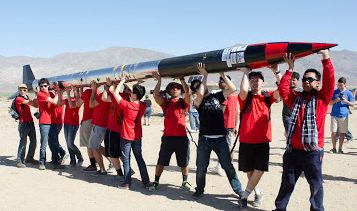By Christine Byrd, Base 11
The Base 11 Space Challenge is a $1 million competition for the first student-led university team to build a liquid-fuel rocket that reaches 100,000 km, the Karman Line. No university team to date has reached the Karman line with a solid hybrid for liquid fuel rocket. But recently we were asked: what is the current altitude record for a liquid-propulsion rocket developed by students?
That question turned out to be surprisingly difficult to answer.
There are two main reasons for the difficulty. First, there’s a plethora of articles whenever a team sets out to achieve a huge goal, like reaching the Karman Line or breaking an existing altitude record. But there is little to no media coverage after the fact, when the mission doesn’t achieve its stated goal. That’s too bad, because even if the rocket didn’t perform exactly as planned, it’s still usually a pretty impressive feat.
The other challenge in determining the existing altitude record is that the information is usually self-reported by teams. While the students report in good faith, they are not all using the same technology to measure their apogee, and the reliability of the measurements could vary considerably. (This is why it’s important that the Base 11 Space Challenge, with $1 million on the line, will use radar as a third-party validation of apogee.)
Nevertheless, after a few emails and some online sleuthing, here’s what we’ve found:
- In 2015, San Diego State University used a surplus engine, Rocketdyne’s LR-101, to launch their Galactic Aztec rocket to about 13,000 feet. (Read more about the mission here.) It’s worth noting that teams competing in the Base 11 Space Challenge are permitted to use off-the-shelf components, including a surplus or commercial engine.
- In 2018, UCLA used an ethanol and LOx engine developed by students, to launch its Odyssey 1 rocket to more than 12,500 feet. (Read more about this mission here or here.) The student teams we spoke with tend to agree that this is the record for a rocket powered by a student-built liquid bipropellant engine.
Momentum in liquid-fuel rocketry continues building at college campuses. In June 2018, three teams brought liquid-propellant rockets to the Spaceport America’s Cup (formerly IREC) — a competition that has historically been dominated by solid and hybrids. Two of the liquid bipropellant rockets were successfully launched and recovered. Colorado State University with their nitrous oxide-powered Ares IV, as well as University of Michigan’s nitrous oxide and ethanol rocket. You can see the incredible GoPro view of MASA’s flight here. Both teams reached a self-reported apogee of roughly 3,800 feet.
Over the next three years, as the Base 11 Space Challenge kicks into full gear, we expect to see record after record be broken, as more teams test liquid bipropellant engines and push each other to reach for ever-greater heights.
Do you know of a university liquid-fuel rocket launch that surpassed the altitude records listed here? Let us know at [email protected], or leave a comment.
Check out the #B11SpaceChallenge on Twitter, Instagram or Facebook. Or better yet, join us as an team member, mentor or supporter here: www.base11spacechallenge.org.

